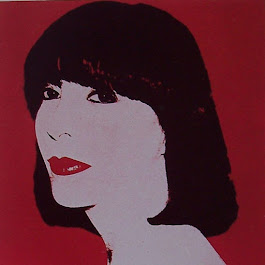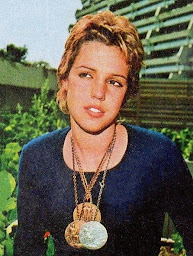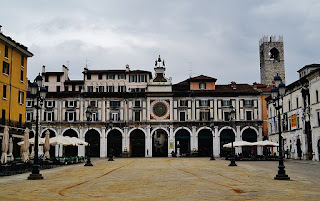Mariuccia Mandelli - fashion designer
'Godmother of Italian fashion' was immortalised by Warhol
Mariuccia Mandelli, the founder of the fashion house Krizia, was born on this day in 1925 in Bergamo in northern Italy. Although Mandelli trained to be a primary school teacher on the advice of her mother and pursued a teaching career when she was in her twenties, she had a talent for sewing and had always been interested in fashion. It took just one lucky break to get her started. When a friend offered her the use of a flat rent-free for six months, Mandelli went to live there, bought an old sewing machine and started making clothes. She then launched her label, Krizia - a name by which she was sometimes known - by selling the clothes from her small car, a Fiat 500. She used to drive to shops in Milan with suitcases full of samples and by 1954 had established a ready-to-wear fashion house. Mandelli also went on to establish a popular line of men’s wear, one of the first female fashion designers to do this successfully. In 1964, Mandelli unveiled her first black-and-white collection at the Palazzo Pitti in Florence, the designs for which earned her a Critica della Moda award. Krizia grew rapidly during the 1960s and 1970s. Read more…
__________________________________________________________
Bernardo Provenzano - Mafia boss
Head of Corleonesi clan dodged police for 43 years
Bernardo Provenzano, a Mafia boss who managed to evade the Sicilian police for 43 years after a warrant was issued for his arrest in 1963, was born on this day in 1933 in Corleone, the fabled town in the rugged countryside above Palermo that became famous for its association with Mario Puzo's novel The Godfather. The former farm labourer, who rose through the ranks to become the overall head - il capo di tutti i capi - of the so-called Cosa Nostra, lived for years under the eyes of the authorities in an opulent 18th century villa in a prestigious Palermo suburb, although ultimately he took refuge in the hills, alternating between two remote peasant farmhouses. He was finally captured and imprisoned in 2006 and died in the prisoners' ward of a Milan hospital 10 years later, aged 83. Although Provenzano assumed power during one of the bloodiest periods in Mafia history, he was eventually credited with rescuing the organisation from the brink of collapse by turning away from the violent path followed by his predecessor as capo di tutti i capi, Salvatore 'Toto' Riina, and restoring traditional Mafia values. Read more…
_________________________________________________________
Daniela Bianchi - actress
James Bond’s love interest whose Italian accent was never heard
Daniela Bianchi, an actress best known for her role as a Bond girl in the film From Russia With Love, was born on this day in 1942 in Rome. She played Russian agent Tatiana Romanova in the hit 1963 film starring Sean Connery as James Bond, although her voice had to be dubbed because of her Italian accent. Daniela’s parents originally came from Sirolo in Le Marche. Her father was a retired Italian army colonel and one of her grandmothers was a Marchesa. Daniela was raised in Rome, where she studied ballet for eight years, and she then went on to become a fashion model. She was the winner of Miss Rome in 1960 and then runner-up in the Miss Universe contest the same year, where she was also voted Miss Photogenic by the press. Daniela was chosen over 200 other actresses by the Bond producers for the role of Tatiana Romanova and, at the age of 21, was the youngest ever main Bond girl. She was also the only Italian to be a main Bond girl. Her character, Tatiana, was a Russian cipher clerk who had been sent by Soviet Army Intelligence to entrap James Bond. Before and after making From Russia With Love, Daniela appeared in many French and Italian films. Read more…
_________________________________________________________
Ernesto Basile - architect
Pioneer of Stile Liberty - the Italian twist on Art Nouveau
The architect Ernesto Basile, who would become known for his imaginative fusion of ancient, medieval and modern architectural elements and as a pioneer of Art Nouveau in Italy, was born on this day in 1857 in Palermo. His most impressive work was done in Rome, where he won a commission to rebuild almost completely the Palazzo Montecitorio, the home of the Chamber of Deputies of the Italian parliament. Yet his most wide-ranging impact was in Sicily, where he followed in the footsteps of his father, Giovan Battista Filippo Basile, in experimenting with the Art Nouveau style. Basile senior designed the Villa Favaloro, in Piazza Virgilio off Via Dante, and with Ernesto and others, notably Vincenzo Alagna, taking up the mantle, it was not long before entire districts of the city were dominated by Stile Liberty, the Italianate version of the Art Nouveau that took its name from the Liberty and Co store in London's Regent Street, which sold ornaments, fabric and objets d'art to a refined clientele and encouraged modern designers. Fine examples of Ernesto Basile’s architecture in Palermo include the Villino Florio (1899–1902) in Viale Regina Margherita, and the Hotel Villa Igiea (1899–1901) on the waterfront. Read more…
________________________________________________________
Charles Edward Stuart – royal exile
Bonnie Prince Charlie’s heart will forever be in Frascati
The Young Pretender to the British throne, sometimes known as Bonnie Prince Charlie, died on this day in 1788 in Rome. The man who would have been King Charles III was born and brought up in Italy where his father, James, the son of the exiled Stuart King James II, had been given a residence by Pope Clement XI. Charles Edward Stuart was raised as a Catholic and taught to believe he was a legitimate heir to the British throne. In 1745 Charles sailed to Scotland hoping to gather an army to help him place his father back on the thrones of England and Scotland. He defeated a Government army at the Battle of Prestonpans and marched south. He had got as far as Derbyshire when the decision was made by his troops to return to Scotland because of the lack of English support for their cause. They were pursued by King George II’s son, the Duke of Cumberland, who led troops against them at the Battle of Culloden in 1746. Many of his soldiers were shot and killed and the surviving Jacobites fled. They were pursued by Cumberland ’s men, who committed atrocities against them when they were caught. Read more…
_________________________________________________________
Don Bosco – Saint
Father and teacher who could do magic tricks
Saint John Bosco, who was often known as Don Bosco, died on this day in 1888 in Turin. He had dedicated his life to helping street children, juvenile delinquents and other disadvantaged young people and was made a saint by Pope Pius XI in 1934. Bosco is now the patron saint of apprentices, editors, publishers, children, young delinquents and magicians. He was born Giovanni Bosco in Becchi, just outside Castelnuovo d’Asti in Piedmont in 1815. His birth came just after the end of the Napoleonic Wars that had ravaged the area. Bosco’s father died when he was two, leaving him to be brought up by his mother, Margherita. Mama Margherita Occhiena would herself be declared venerable by the Catholic Church in 2006. Bosco attended Church and grew up to become very devout. Although his family was poor, his mother would share what they had with homeless people who came to the door. While Bosco was still young, he had the first of a series of dreams that would influence his life. He saw a group of poor boys who blasphemed while they played together, and a man told him that if he showed meekness and charity he would win over these boys. Read more…


































